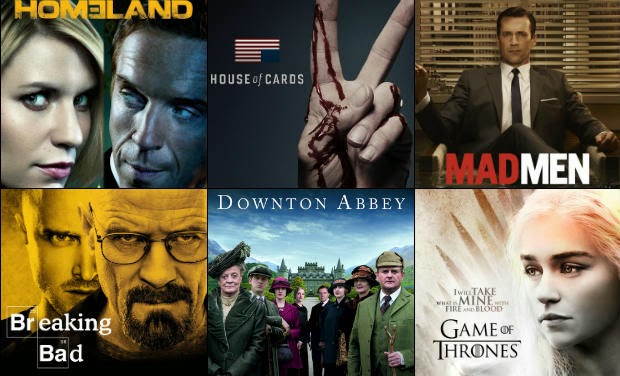Game of Thrones
Thursday 30 April 2015
Thursday 23 April 2015
Editing - revision
Task 1:
Discuss the following with a partner.
Task 2:
Brainstorm all the different types of editing you can.
Task 3:
Now write what each type of editing does - and importantly - the effect of the editing.
Task 4:
Look at the editing hand-out - have you missed any areas of editing? Have you misunderstood any areas, what they do, and their effects?
Task 5:
Get into pairs - enough for seven groups.
In your pair you are going to analyse a clip for editing - looking at specific area of representation. You have 20 mins to watch the clip and produce a short presentation for the rest of the class (of no more than 5 mins).
In your presentation you should include:
Areas of representation and clips:
Independent revision
Excellent website for revising editing - including clips and explanations.
Areas of representation and music videos:
Discuss the following with a partner.
- What is the point of editing?
- What does it achieve?
- What effect does it have in TV drama?
Task 2:
Brainstorm all the different types of editing you can.
Task 3:
Now write what each type of editing does - and importantly - the effect of the editing.
Task 4:
Look at the editing hand-out - have you missed any areas of editing? Have you misunderstood any areas, what they do, and their effects?
Task 5:
Get into pairs - enough for seven groups.
In your pair you are going to analyse a clip for editing - looking at specific area of representation. You have 20 mins to watch the clip and produce a short presentation for the rest of the class (of no more than 5 mins).
In your presentation you should include:
- A brief introduction that rounds up what impact the editing has on the ENTIRE clip
- Screen shots of editing features you have found
- Terminology
- Explanation of the effect of those shots IN RELATION TO REPRESENTATION
Areas of representation and clips:
- Age - Skins
- Gender - Wire in the Blood
- Sexuality - Queer as Folk
- Ethnicity - Spooks
- Disability/ability - The Street
- Class and status - Shameless
- Regional identity - Our Friends
Independent revision
Excellent website for revising editing - including clips and explanations.
Areas of representation and music videos:
- Age - Modestep (Sunlight)
- Gender - Pink (Stupid Girl)
- Sexuality - Beyoncé (1+1)
- Ethnicity - Offspring (Pretty Fly for a White Guy)
- Disability/ability - Eminem (Without Me)
- Class and status - All American Rejects (Gives You Hell)
- Regional identity - Fat Les (Vindaloo)
Wednesday 15 April 2015
Sherlock - exam practise
Task 1:
- Get into 4 groups
- Each group is responsible for one area of textual analysis
- Watch the clip
- Write down every feature for your area of TA that you can see in the clip and when it is used
- Swap your paper with another group
- Annotate your new sheets with how the TA feature has been used to represent gender
- Swap your paper with another group
- Add to your peers' discussion with further ideas/different interpretations
- Swap your paper with another group
- Add any theories you've covered in class with relation to gender/representation that you could use to support the arguments on the paper
- Return the paper back to the original group
Task 2:
- Spend 10 mins preparing a short presentation on your area of TA
- Take notes and ideas from your peers' work on representation in the clip
Task 3:
- Using the notes you've made, write up an exam answer to the question: How is gender represented in the clip from Sherlock Holmes?
Examiner's report - Media Studies key concepts G322/3
Examiner's reports are really helpful as they can reveal what the examiner is looking for when marking your exam answers. Some key points from last year's examiner's report:
Representation and textual analysis:
Areas of representation:
Areas of textual analysis:
- Those candidates achieved well offered sustained and detailed responses.
- Responses were frequently punctuated with detailed reference to contemporary and relevant examples.
- Fully rewarded for some insightful and academic use of key media concepts
- Candidates who did not meet the highest levels often lacked detail in arguments and offered a basic response.
- Candidates struggled where they failed to manage their time.
Representation and textual analysis:
- Integration of terminology
- Variety in representations - not just focused on one type
- Fluctuation in representation - not the same all the way through the clip
- Sequenced ideas - work your way through the clip
- Balanced and integrated analysis - covering all areas of TA
- Biggest area of development in all responses is editing
- Links need to be made between areas of TA and the representation
Areas of representation:
- Gender, age, ethnicity, sexuality, class and status, disability/ability, regional identity
Areas of textual analysis:
- Camera shots, angle movements, composition
- Establishing shots, master shot, close-up, mid-shot, long shot, wide shot, two-shot, aerial shot, point of view shot, over the shoulder shot, variations.
- High angle, low angle, canted angle.
- Pan, tilt, track, dolly, crane, steadicam, hand-held, zoom, reverse zoom.
- Framing, rule of thirds, depth of field, deep and shallow focus, focus pulls.
- Editing
- Shot/reverse shot, eyeline match, graphic match, action match, jump cut, crosscutting, parallel editing, cutaway, insert.
- Dissolve, fade-in/out, wipe, superimposition, long/short take, slow motion, ellipsis, expansion of time, post-production, visual effects.
- Sound
- Score, incidental music, themes and strings, ambient sound
- Diegetic and non-diegetic sound, synchronous/asynchronous, sound effects, sound motif, sound bridge, dialogue, voiceover, mode of address/direct address, sound mixing, sound perspective.
- Mise-en-scene
- Production design, location, studio, set design, costume, make up, properties
- Lighting
- Colour design
Subscribe to:
Posts (Atom)
